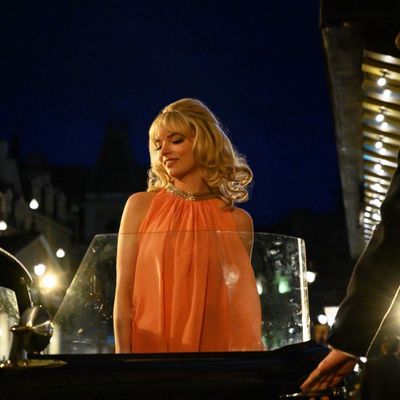
If I told you Edgar Wright’s Last Night in Soho was a soundtrack movie, would you understand what I meant? It’s not just a movie with a lot of music cues or with a great soundtrack. A soundtrack movie is a movie that feels like a 90-minute mixtape, the cinematic equivalent of someone putting a pair of headphones on your head and saying, “You gotta listen to this.” Garden State, which features literally that exact scene, is the crowning example of a soundtrack movie. Others include Marie Antionette, Guardians of the Galaxy, and, as my friends at This Had Oscar Buzz recently pointed out, anything by Cameron Crowe. (When that same spirit bleeds into the production design and cinematography, a soundtrack movie becomes a dollhouse movie. Wes Anderson makes a lot of dollhouse movies.)
So, yes, Last Night in Soho, which had its North American premiere at TIFF on Friday, is Wright’s soundtrack movie, even more so than Baby Driver, which had its main character shout out the Jon Spencer Blues Explosion in the opening scene. It follows Eloise Turner (Thomasin McKenzie), a naïve fashion student in London who is obsessed with the Swinging ’60s. (She was raised by her grandmother, see, after her mother died in tragic circumstances …) The country mouse Eloise doesn’t fit in with her big-city classmates, so she rents a room in Soho thta comes with a unique amenity: Every night after she falls asleep, she wakes up as Sandie (Anya Taylor-Joy), an aspiring singer living in the same flat in 1965. For a girl steeped in ’60s nostalgia, it’s quite literally a dream come true — until the spirit of the past starts bleeding into the present with disturbing consequences. Finally, cinema has blessed us with a second Miss Turner, who best start believin’ in ghost stories because she’s in one!
Without spoiling too much, Eloise thinks she’s in “Waterloo Sunset” London but finds she’s actually in a meaner, grittier London: the London of the Profumo affair, of the Krays, of Alfie (a movie that’s remembered as a fun, sexy romp and that only upon a rewatch will you recall is incredibly depressing). But the good news is both Londons had amazing music, and the movie gives us a feast of mid-’60s pop. Unlike, say, Cruella, which was content to simply trot out the old hits, Last Night in Soho has fun putting its own spin on the period classics — Sandie’s breathy rendition of Petula Clark’s “Downtown,” a party scene where the Kinks in Eloise’s headphones blend with modern grime, a stunning dance sequence where the two girls seamlessly swap places, which Wright afterward revealed was done entirely in camera. He pulls the ultimate soundtrack-movie gag of using the less-famous versions of iconic songs — in this case, two ’60s titles whose covers became big hits in the ’80s, Sandie Shaw’s “(There’s) Always Something There to Remind Me” and James Ray’s “Got My Mind Set on You.” You can almost feel the director winking at you: You’ve heard the original, of course — haven’t you?
Aside from its music, the film is a feat of casting —and not only in its pairing of McKenzie and Taylor-Joy, the industry’s favorite young actresses of the moment. As part of his homage to ’60s British cinema, Wright fills out the ensemble with stars of yesteryear. Rita Tushingham, who broke out as a teen star in A Taste of Honey, is Eloise’s grandma; hunky Terence Stamp is a punter with a secret; the late, great Diana Rigg is the landlady, who gets the film’s best line. When Eloise tearfully informs her she thinks someone once died in the bedroom, she responds, “This is London. Someone has died in every room.”
It’s this sort of thing that, throughout Last Night in Soho, made me keep thinking of another movie: Fred Schipisi’s Last Orders. That film, which premiered at TIFF exactly 20 years ago, got a lot of poignancy out of casting young guns from ’60s classics — Michael Caine, David Hemmings, Tom Courtenay — as old men grappling with aging and loss. (It got still more from the fact that it was playing the morning the Twin Towers collapsed.) The two films don’t have all that much in common, since one is a middlebrow literary adaptation and the other pulpy psychological horror. But they bookend a period when the ’60s were gradually fading from living memory, transforming from people’s actual experience into a meaning passed down solely through pop-culture iconography. Last Night in Soho’s greatest trick is that it is both an analysis and an example of this phenomenon. What’s it all about, Edgar?


